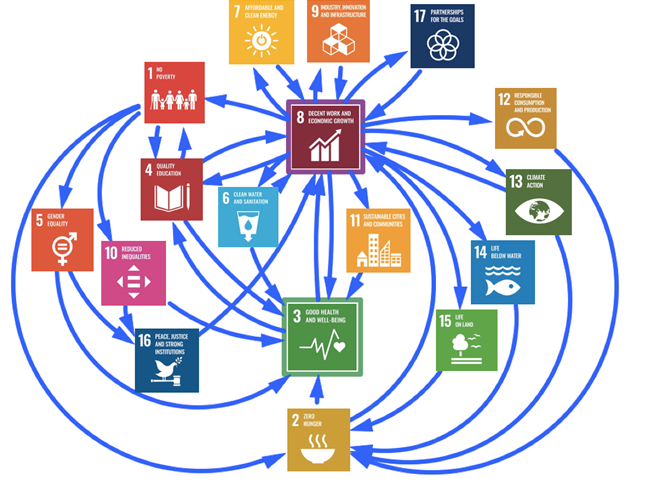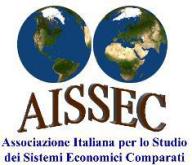By Joe E. Colombano[*] and David N. Nabarro[†]
Introduction: the dynamic symbiosis between the virus and the SDGs
If there is one lesson to be learned from the Covid-19 pandemic is that humanity and the planet it inhabits are tightly linked in a sophisticated whole of interconnected systems. These systems encompass the reality of the biosphere and the constructs of our society, its politics and the economy, and are all tied together in a dynamic symbiosis of interconnections and couplings of varying strength. Life, in every form, is at the center of such “system of systems:” from the microscopic of a virus to the macroscopic of the animal kingdom, the global commons and the world economy. Because of its complexity, however, such a structure is vulnerable to sudden catastrophic collapse triggered by small and at times insignificant events in any one of the constituent systems (Efatmaneshnik, et al. 2016).
One such event occurred late last year, when an unknown virus jumped from a wild animal, probably a bat, to a human, possibly in a wet market in Wuhan, China, thus transmitting the Severe Acute Respiratory Syndrome Corona Virus 2 (SARS-CoV-2) responsible for the coronavirus disease 2019 (Covid-19). Since then, this zoonotic virus spread as a pandemic of unprecedented speed and reach, infecting over 3.5 million people, killing over 250,000, and causing a global recession of historical proportions in May 2020. These numbers are still increasing, as Covid-19 continues to wreak havoc around the world, at least until a vaccine or a therapy are found and made available to all.
The pain inflicted by the pandemic is likely to have deleterious effects on the pursuit of sustainable development, the concept that more than others reflects a “system of systems” approach in the way in which it combines and juxtaposes socio, economic and environmental aspects of human activity and their inter-linkages, co-benefits and trade-offs.
In this article, we take a “system of systems approach” and consider how the virus impacts on sustainable development as expressed through the 17 Sustainable Development Goals of the 2030 Agenda for Sustainable Development.[1] While we recognize that this is a very preliminary analysis, largely based on qualitative and subjective interpretations and anecdotal evidence, we nevertheless believe it can be helpful in bringing some form of order to the analysis of the effects brought about by the Covid-19 pandemic, and the shocks that it inflicts to the complex network of relationships, co-benefits and trade-offs that constitute sustainable development.
First-order dynamics: direct and indirect effects of Covid on the SDGs
Because of its exponential pace of growth and the consequences of the measures required to contain it, the Covid-19 pandemic is a formidable challenge to human progress and the realization of the more equitable and sustainable future envisioned by the 2030 Agenda for Sustainable Development. Like any phenomenon that concerns human beings, its relationship to the natural world and its interactions within social constructs such as politics and the economy are complex. Indeed, the way in which the pandemic and the resulting health care crisis is linked to financial, economic and social crises forms a system of circular, interconnected, fast shifting and highly complex elements. We see this system of interactions between the virus and the SDGs as an interconnected and dynamic symbiosis amongst living systems.
The virus impacts each of the goals both directly, by way of its effects on health outcomes, but also indirectly, due to the consequences of the extreme measures needed to contain it (i.e. lockdowns). Covid-19 is a highly contagious virus: each infected person can transmit it to up to three people, and the infectious phase can often be asymptomatic, with people unaware of being a danger to others. As a result, the number of cases doubles every two and a half days on average. This makes it hard to suppress infections completely. A vaccine or a cure will help, but at present they remain under development, and it will be many months before they are made safe and widely available to everyone, including in the developing countries.
Direct effects
The rates of morbidity and mortality of the virus exert a direct impact on the achievement of the SDGs. At the time of writing, the novel coronavirus Covid-19 is affecting 212 countries and territories around the world. The total number of cases is estimated in excess of 18 million people, with around 700,000 deaths (WHO 2020). Out of 100 cases of Covid-19, on average the largest share is asymptomatic of mild, with only around 15-20 requiring hospitalization including in Intense Care Units (ICU), and around 3-5 succumbing to the virus. These numbers risk reversing the global progress achieved on health outcomes as measured by SDG3 on healthy lives and well-being for all at all ages. The most vulnerable, including women, the elderly, and informal workers, are hit the hardest.
Mortality and morbidity rates of Covid-19 also translate in a direct effect on the size and health of the labor force and its productivity, which in turns impact, for example, the fight against poverty (SDG1), the number of people at risk of famine (SDG2), education outcomes (SDG4), economic growth and employment (SDG8), and more. In addition, Covid-19 mortality rates also get compounded with the number of unnecessary deaths occurring because of the surge in demand for hospitalization, which rapidly overwhelms health systems, including in advanced countries with high level of capacity, when hospitals struggle or fail to accommodate demand, especially for ICU beds, and resources get shifted to front the pandemic emergency. Unnecessary deaths also occur when chronic patients with other diseases than Covid-19 postpone their treatment due to fear of coming into contacts with Covid-19 patients in hospitals and health centers where they would otherwise go regularly.
Indirect effects
In addition to the direct negative effects of the virus on health outcomes, SDGs implementation also suffers from the impact of the measures adopted to contain the pandemic. We refer to such impact as indirect effects of the virus. They largely come from the consequences of countries requiring their people to shelter in place, therefore effectively imposing a lockdown of their society and the stalling of their economy. Lacking a vaccine or a treatment for Covid-19, lockdowns are the only viable measure to interrupt the transmission of the virus. Around half of the world population has experienced some sort of lockdown due to the pandemic.
While necessary, lockdowns have immediate and devastating consequences for all the SDGs. The artificial stop of the economy results in supply and demand shocks and a sudden drop in economic output: with estimates ranging between negative 6 and negative 40 percent, the recession expected for the second quarter of 2020 is likely to be one of the most severe on record, with historical levels of unemployment and deprivations. Sectors such as transportation, retail trade, leisure, hospitality and recreation have all been affected. A recent UN report on the crisis describes how supply chain disruptions have halted the manufacturing industry. This, combined with falling commodity prices, in particular oil, exacerbates the impact of the pandemic, and rattles the financial markets. In the developing countries, this has tightened liquidity conditions, and created unprecedented outflows of capital (United Nations 2020).
Resilience dynamics: SDGs progress as a proxy for Covid-readiness
The “resilience dynamic” effect is based on the consideration that societies that have made most progress on the achievement of the SDGs are also those that are likely to be better prepared to cope with the COVID-19 pandemic. In this sense, the level of SDGs achievement in a specific country can be considered a measure of its Covid-readiness. Put in other terms, the advancement on SDG implementation contributes to building resilient societies, which are able to better cope with the impact of the pandemic. The opposite is also true: societies that are lagging behind in implementing the SDGs are also more likely to be more impacted by the spreading of the virus and less able to cope with its consequences.
Take, for example, the first line of defense against the virus, as recommended by the WHO: frequent handwashing. This is explicitly included in SDG indicator 6.2.1 (b), which measures the proportion of population using a hand-washing facility with soap and water. While this is part of daily hygiene measures for many, the latest SDGs Progress Report reminds us that 2 out of 5 people worldwide do not have a basic hand-washing facility with soap and water at home. In the least developed countries, it is less than one out of three people (28 percent). This means that, globally, an estimated 3 billion people are still unable to properly wash their hands at home, and are therefore deprived of the most basic and effective prevention measure against Covid-19 (United Nations 2019). So countries that are lagging behind on implementing SDG 6 are more at risk of being impacted by the pandemic.
Similarly, it can be argued that in general the pandemic is more likely to affect those communities that are already at risk, as indicated by lack of progress on SDGs implementation. Examples include SDGs 3 on universal health coverage, as the virus is more likely to affect those whose health is already compromised, or on health emergency preparedness; or SDG 11, because people living in slums or densely populated urban areas are less able to adopt basic hygiene and social distancing measures to prevent the virus; or SDG 15, on the sustainable use of biodiversity, including to address the demand and supply of illegal wildlife products, which are considered to play a part in causing zoonotic diseases such as Covid-19; or SDG16 (Promote peaceful and inclusive societies for sustainable development, provide access to justice for all and build effective, accountable and inclusive institutions at all levels), because population caught up in or fleeing war and persecution are left unable to adopt precautionary measures against the virus and lack access to basic social and political protections or any support system (United Nations 2020).
Inter-linkages dynamics: Covid-19 and the integrated nature of the SDGs
The analysis of the impact of the Covid-19 pandemic on an integrated system such as the SDGs requires exploring the inter-linkages between the goals. In a system of complex dynamics characterized by many feedback loops, time delays of varying durations, nonlinear patterns of growth and decline, and differing tipping points, any interruption affecting one SDG could result in cascading effects across the others. This calls for a dynamic systems approach to understand the complexity of the problem and suggest policies to solve it.
Figure 1. A systems map of Covid-19 and its effect on the SDGs

Source: Adapted from Millennium Institute’s iSDG model.
Figure 1 provides a system map of Covid-19 and its effect on the SDGs. The diagram is adapted from the Integrated Sustainable Development Goals (iSDG) Model, a policy simulation tool developed by Washington, D.C.’s Millennium Institute to help policy makers make sense of the complex web of interconnections between the SDGs.[2] The model integrates economic, social, and environmental factors and includes elements of complexity, such as feedback relationships, non-linearity and time delays, that are fundamental to fully understand the dynamics of development. While not as sophisticated as a simulation, the diagram helps making sense of some of the dynamics triggered by the Covid-19 virus on the SDGs.
The diagram illustrates some of the feedback loops resulting from the introduction of drastic lockdown measures adopted to contain the pandemic. A feedback loop is a process in which the outputs of a system are circled back and used as inputs. Most of the feedback loops we describe in this section stem from the effect on economic growth and unemployment (SDG 8), which increases significantly in the short term, due to the sudden closure of the economy, but also persists over time, as economies are slow to restart once the lockdowns are gradually released.
A first simple feedback loop describes the relationship between unemployment (SDG 8), poverty and hunger (SDG 1 and 2) and health (SDG 3). In this case, individuals left without jobs become more prone to falling under the national poverty lines, and thus exposed to hunger and malnutrition. This in turn affects their health, which in turns prevents them from being able to rejoin the labor force. Another feedback loop links together SDG 8, 4 and 1. As jobs are lost due to the closure of the economy (SDG 8), household incomes decline (SDG 1), which in turn leads to an increase in school dropouts (SDG 4), either because families can no longer afford school fees, or because the opportunity cost of keeping children in school is too high, as they can be more helpful in the short term at home. By not completing their education (SDG 4), however, these children are less likely to get a well-paid job in the future (SDG 8) and are therefore at higher risk of poverty (SDG 1).
Often, it is possible to identify longer chains of feedback loops across SDGs. Consider, for example, that the jobs lost to the Covid-19 pandemic are disproportionately held by the working poor, whose job security is lowest, and by women, as they are forced to stay home to care for the children at home from school. Such effects of unemployment (SDG 8) on gender (SDG 5) and social inequalities (SDG 10) are exacerbated by lack of access to basic services such as health (SDG 3) and education (SDG 4) for the same groups, which in turns affects social cohesion (SDG 16) therefore threatening economic stability (SDG 8), and creating more unemployment (SDG 8) and poverty (SDG 1).
In addition to being an effective diagnostic tool, feedback loops are also useful in guiding government policy and expenditure allocation. Faced with the pandemic, governments have rightly invested in the strengthening of public health systems (SDG 3). However, given the budget constraint under which most countries operate, especially in the developing world, and the pressures to restart the economy, governments may be tempted to divert public resources away from the social sector, and invest instead in key productive industries and infrastructure (SDG 8 and 9), as it is often done to boost productivity. Often, these decisions are at the expense of sectors such as education (SDG 4), or water infrastructure (SDG 6), and access to electricity (SDG 7). In such cases, feedback loops such as those described above are helpful to clarify the impact of these choices, especially when they could weaken the response to Covid-19 and other diseases (for example by weakening water and sanitation infrastructure).
International cooperation and environmental policies may also become targets for cutting costs in the face of as severe a recession as that triggered by the Covid-19 crisis. Such decisions may be taken more easily now that populist parties are in power, or because lockdowns have brought about cleaner air (SDG 11) and more sustainable consumption patterns (SDG 12). However, building climate resilience (SDG 13), and increasing marine and land protection (SDG 14 and 15) is dependent on continuous investment and would suffer greatly from such cuts. In these cases, feedback loops are helpful to illustrate the risk of severe economic losses (SDG 8) resulting from neglecting climate action (SDG 13), or the risks of hunger (SDG 2) and adverse health outcomes (SDG3) from weakened agricultural yields and fish stocks, if marine and land areas were to be neglected (SDG 14 and 15). Similarly, cutting international aid (SDG 17) would also have adverse economic effects by weakening trading partners (SDG 8), increasing poverty in the developing world (SDG 1) hence increasing the likelihood of migration (SDG 10), and preventing coordinated action to address global challenges such as climate change (SDG 13).
Most of the feedback loops illustrated in the diagram above focus on the chains of effects triggered by the shutting down of the economy to contain the pandemic. While such a measure can be lifted relatively quickly, the economy will take time to rebound to pre-crisis level. Given the inherent inertia of the sustainable development system, any interruption is likely to severely set back progress towards the SDGs. Understanding the complexity of the system and its fragility is the first step towards making the right decisions for planning the recovery and building more resilient societies.
Conclusions
Covid-19 is not a “black swan,” an unpredictable event with massive impact on a global scale. On the contrary, many predicted the spreading of a respiratory infection caused by a coronavirus and warned us that the world was not going to be ready to deal with it.[3] Cassandras all of them, as their predictions were largely met, if not with incredulity, certainly with inaction. And yet it was not outlandish to foresee that the “system of systems” in which we live is complex enough that any unexpected event, even if small, can undo it, in accordance with the well-known risk management formula complexity x uncertainty = fragility.
In this article we looked at the complexity of the sustainable development systems, and analyzed the relationships that exist between the Covid-19 virus and the SDGs. We found that these exist in a dynamic symbiosis in which not only does the virus affects the chances of achieving the goals, but also the extent to which progress has been made in achieving the goals determines the level of Covid-19 resilience of societies. We also found that the virus’ impact on the SDGs is profound and largely negative, with perhaps the most important lesson being about the level of inequality exposed by the virus. Far from being the great equalizer it was initially thought to be, Covid-19 hits hardest the poor and most vulnerable. The only real positive effect of the crisis is that it has put the resilience of public health systems at the center of the political debate.
It would be wrong to make any precise recommendation for policy on the basis of the preliminary considerations outlined above. However, it is possible to indicate a number of general principles to keep in mind as we consider the actions to take in response to the Covid-19 crisis, while continuously learning about it and its impacts on sustainable development. These general principles include the following:
- Managing complexity is a critical element of policy making for sustainable development: given the sophisticated interactions between the several dimensions of sustainable development, it is important to understand how complex such system is, and how far it lies from its critical complexity limit, i.e. the threshold beyond which a system can unexpectedly fail. Because uncertainty cannot be controlled, the only alternative is to manage complexity.
- Building resilience is key to sustainable development: Building resilient societies will be critical to our ability to respond to the current Covid-induced crisis and achieve a sustainable future. Giovannini et. al. (2017) put it best: “Being resilient means that we are able to stay on – or move towards – the sustainable development path, even if we are challenged away from it, as it is happening now with the Covid-19 pandemic.”
- Crisis response needs a global coordination and local feedback: Covid-19 is a multidimensional pandemic of global proportion. The response to it needs to be commensurate in scope and nature. Policy solutions to the crisis will be most effective when globally coordinated and locally informed, with a whole-of-system approach.
- The SDGs must be at the core of the response to the Covid-19 crisis: the global reset triggered by the crisis is an opportunity for a better recovery, to rebound forward towards realizing a sustainable world, rather than backward to the original system with its flaws, as we did, for example, after the 2008 financial crisis. For this to happen we need to strengthen our commitment to implement the 2030 Agenda and invest in meeting the 17 goals. This is how we can turn this global pandemic into the opportunity to start anew and realize the vision of a fairer and more sustainable world.
References
Efatmaneshnik, M., Bradley, J. and Ryan, M.J. (2016). ‘Complexity and fragility in system of systems’, International Journal of System of Systems Engineering, Vol. 7, No. 4, pp.294–312.
Giovannini, E., Manca, A., and Benczur, P. (2017). “Building a scientific narrative towards a more resilient EU society, Part 1: a conceptual framework,” in JRC Science for Policy Report, Joint Research Center of the European Commission. https://publications.jrc.ec.europa.eu/repository/bitstream/JRC106265/jrc106265_100417_resilience_scienceforpolicyreport.pdf
United Nations (2019). The Sustainable Development Goals Report 2019. New York: United Nations. https://unstats.un.org/sdgs/report/2019/The-Sustainable-Development-Goals-Report-2019.pdf
United Nations (2020). Shared Responsibility, Global Solidarity: Responding to the socio-economic impacts of COVID-19. New York: United Nations. https://unsdg.un.org/sites/default/files/2020-03/SG-Report-Socio-Economic-Impact-of-Covid19.pdf
WHO Coronavirus disease (COVID-19) Situation Reports. https://www.who.int/emergencies/diseases/novel-coronavirus-2019/situation-reports
** This is the abridged version of a longer paper accepted for publication in Kakar, N., Robinson, N. and Ottinger, R. (forthcoming). Implementing the SDGs: Strategies for a Livable World. Routledge, New York (TBC).
[*] Senior Advisor, MainStreet Partners, London; former Director for Sustainable Development and Climate Change, Executive Office of the UN Secretary-General, New York
[†] Special Envoy of the WHO Director General on COVID-19, Geneva; Co-Director of Global Health Innovation, Imperial College, London; Strategic Director, 4SD, Geneva.
[1] In this article we refer interchangeably to SDGs and the 2030 Agenda for Sustainable Development.
[2] The authors are grateful to Derek Chan of the Millennium Institute for his contribution to the original paper.
[3] A non-exhaustive list includes infectious disease expert Dennis Carroll, former USAID Administrator Andrew Natsios, epidemiologist Michael Osterholm, Pulitzer Price-winner Laurie Garrett, epidemiologist Larry Brilliant, global-health expert Alanna Shaikh, philanthropist Bill Gates, and virologist Robert G. Webster.









